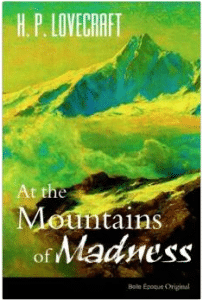 Classic, Creeping Horror
Classic, Creeping Horror
By: H.P. Lovecraft
Ancient secrets lie deep, encased in eons of snow and ice, until an Antarctic expedition awakens them. The year is 1930 and the drive for exploration both geological and historical has captured an adventurous group on a routine science expedition. Their story has been falsified, glossed over, and hidden, until now when one of the two surviving members, geologist William Dyer, publishes the true epoch of events to dissuade a new expedition from disturbing an ancient evil. Claustrophobic, layered with paranoia and wonder, graced with eloquent language and ancient utterings, At the Mountains of Madness is classic Lovecraft, a vivid novella that evokes scenery and sensation, even the things which are too horrific, too inhuman, to be fully realized by the fracturing mind and the shortcomings of the pen.
An atmosphere similar to John Carpenter’s movie The Thing and its subsequent novelization by Alan Dean Foster, a creeping tale of alien horror and scientific curiosity gone wrong, At the Mountains of Madness is a short read (138 pages, 4 hours if you are listening to the audio edition) that conveys the scope of creation and the temporal fragility of humanity. The descriptions cast readers on ice caps and glacial valleys, tunneling through impacted snow to the core of a desiccated world before time. The science itself, the very methodology of the researchers, engenders authority in a tale of the bizarre and as the tunnels progress deeper, our belief and primordial terror increase.
Characterization is not traditional, rather fear and curiosity, in equal measures, are the characters of this tale which provides a wide lens scope to present not only the expedition’s discovery and final stories, but also the beginnings of the very world itself, described through cyclopean runes in the remains of a eons old city; the famous creatures such as the originators of creation (the Elder Things), the Shoggoths, the Star Spawn of Cthulhu, and the flying Mi-go are present and active within this mad, unraveling world. These fantastical creatures and their intricate societal history coupled with their current condition provide tension that is timeless and compelling.
The writing is voluptuous and verbose, a quality that I personally admire despite the general modern outlook that succinctness provides for better story telling. As a double major in English and Communications in college, a soon to be MA in Writing recipient, and a Technical Writer by day (not to mention amateur novelist and published short story writer), I was glad to enjoy the audio recording since Lovecraft managed to confuse me with his vocabulary and, of course, his fictitious words based on the legends of the Necronomicon for his creatures. Not having to stumble over pronunciation enabled the very peculiarity and inherent oldness of his portrayed world to take root.
I read (or more aptly, listened to) At the Mountains of Madness accidentally, realizing that my usual audio book companion was forgotten at home. A quick Google revealed a Reddit site for youtube audio books. The price being right (it was free) I engaged in my first Lovecraft experience. I have recently been playing the board game Arkham Horror, based on the mythology of Lovecraft’ s unique creation and had also ended up with an adorable C’Thulu plushy, leading me to be curious about all the fuss. The reading I listened to immersed me in the experience and although recorded from an old cassette, it seems to me the only way to meet this dark tale. Needless to say, At the Mountains of Madness also appears in many book collections and in other audio book forms. A week later, after an intensive work training and some serious travel, my mind still keeps drifting back to that cryptic city and Lovecraft’s dizzyingly real world. Unequivocally recommended.
– Frances Carden
- Book Vs Movie: The Shining - April 6, 2020
- Thankful For Great Cozy Mysteries - December 13, 2019
- Cozy Mysteries for a Perfect Fall - October 20, 2019

Leave A Comment